
Alexander Graham Bell was a Scottish-born inventor, scientist, and engineer who is credited with patenting the first practical telephone. He also co-founded the American Telephone and Telegraph Company (AT&T) in 1885.

Impressionism is a 19th-century art movement characterized by relatively small, thin, yet visible brush strokes, open composition, emphasis on accurate depiction of light in its changing qualities, ordinary subject matter, unusual visual angles, and inclusion of movement as a crucial element of human perception and experience. Impressionism originated with a group of Paris-based artists whose independent exhibitions brought them to prominence during the 1870s and 1880s.

The photophone is a telecommunications device that allows transmission of speech on a beam of light. It was invented jointly by Alexander Graham Bell and his assistant Charles Sumner Tainter on February 19, 1880, at Bell's laboratory at 1325 L Street in Washington, D.C. Both were later to become full associates in the Volta Laboratory Association, created and financed by Bell.

In United States history, the Gilded Age was an era extending roughly from 1870 to 1900. It was a time of rapid economic growth, especially in the Northern and Western United States. As American wages grew much higher than those in Europe, especially for skilled workers, and industrialization demanded an ever-increasing unskilled labor force, the period saw an influx of millions of European immigrants.
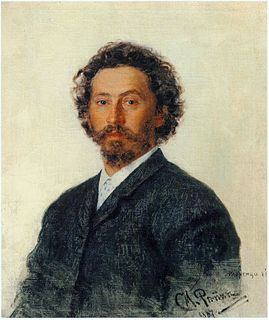
Ilya Yefimovich Repin was a Russian painter. He became one of the most renowned artists in Russia during the 19th century. His major works include Barge Haulers on the Volga (1873), Religious Procession in Kursk Province (1880–1883), Ivan the Terrible and His Son Ivan (1885); and Reply of the Zaporozhian Cossacks (1880–1891). He is also known for the revealing portraits he made of the leading literary and artistic figures of his time, including Mikhail Glinka, Modest Mussorgsky and especially Leo Tolstoy, with whom he had a long friendship.

The Thinker is a bronze sculpture by Auguste Rodin, usually placed on a stone pedestal. The work depicts a nude male figure of heroic size sitting on a rock. He is seen leaning over, his right elbow placed on his left thigh, holding the weight of his chin on the back of his right hand. The pose is one of deep thought and contemplation, and the statue is often used as an image to represent philosophy.
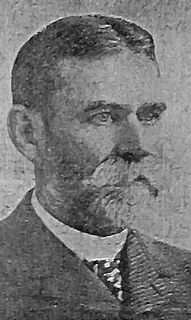
Charles Sumner Tainter was an American scientific instrument maker, engineer and inventor, best known for his collaborations with Alexander Graham Bell, Chichester Bell, Alexander's father-in-law Gardiner Hubbard, and for his significant improvements to Thomas Edison's phonograph, resulting in the Graphophone, one version of which was the first Dictaphone.

The 1880 United States House of Representatives elections, coincided with the 1880 presidential election which was won by James A. Garfield, who was a member of the House at the time.
The Glasgow School was a circle of influential artists and designers that began to coalesce in Glasgow, Scotland in the 1870s, and flourished from the 1890s to around 1910. Representative groups included The Four, the Glasgow Girls and the Glasgow Boys. Part of the international Art Nouveau movement, they were responsible for creating the distinctive Glasgow Style.
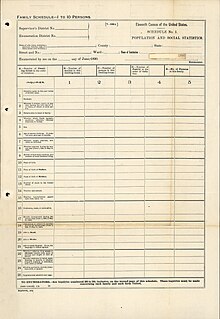
The United States census of 1890 was taken beginning June 2, 1890 but most of the 1890 census materials were destroyed in 1921 when a building caught fire and in the subsequent disposal of the remaining damaged records. It determined the resident population of the United States to be 62,979,766—an increase of 25.5 percent over the 50,189,209 persons enumerated during the 1880 census. The data reported that the distribution of the population had resulted in the disappearance of the American frontier. This was the first census in which a majority of states recorded populations of over one million, as well as the first in which multiple cities—New York as of 1880, Chicago, and Philadelphia—recorded populations of over one million. The census also saw Chicago rise in rank to the nation's second most populous city, a position it would hold until Los Angeles would supplant it in 1990. This was the first U.S. census to use machines to tabulate the collected data.

The United States census of 1880 conducted by the Census Bureau during June 1880 was the tenth United States census. It was the first time that women were permitted to be enumerators. The Superintendent of the Census was Francis Amasa Walker. This was the first census in which a city—New York City—recorded a population of over one million.
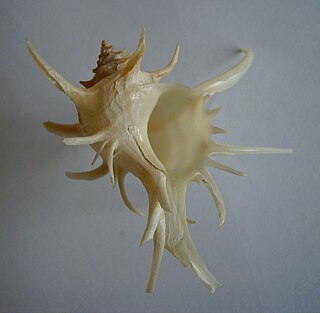
Muricinae is a taxonomic subfamily of predatory sea snails, marine gastropod mollusks within the large family Muricidae, the murex snails and rock snails.
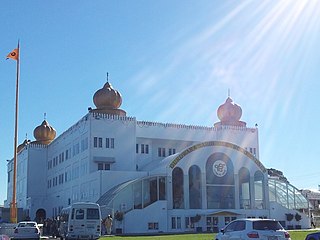
Sikhism is a minority religion followed by 0.5% of the population of Australia. It is the fastest growing religion in Australia since 2011. The Sikhs form one of the largest subgroups of Indian Australians with 125,000 adherents according to the 2016 census, having grown from 12,000 in 1996, 17,000 in 2001 and 26,500 in 2006. Most adherents are Punjabi Australians who can trace their ancestry back to the Punjab region of the Indian Subcontinent, which is currently divided between India and Pakistan.
George Evans Moule was an Anglican missionary in China and the first Anglican bishop of mid-China.
Alumni Oxonienses: The Members of the University of Oxford is a biographical reference work by Joseph Foster (1844–1905), published by Oxford University Press, listing the alumni of the University of Oxford. Foster's work was compiled principally from the colleges' matriculation registers and the university archives, but it also relies on numerous printed and other sources.
Bhavnagar State Railway (BSR) was a metre gauge railway line in Bhavnagar State, now part of Gujarat in India.

The 1880 Princeton Tigers football team represented the College of New Jersey, then more commonly known as Princeton College, in the 1880 college football season. The team finished with a 4–0–1 record and was retroactively named co-national champion by the National Championship Foundation and Parke H. Davis. This season was Princeton's tenth national championship and one of 11 in a 13-year period between 1869 and 1881. The captain of the team was Francis Loney.
The 1880 Yale Bulldogs football team represented Yale University in the 1880 college football season. The team finished with a 4–0–1 record, did not allow opposing teams to score a single point, outscored all opponents, 30–0, and was retroactively named national champion by the Billingsley Report and as co-national champion with Princeton by the National Championship Foundation and Parke H. Davis.
The 1880 Harvard Crimson football team represented Harvard University in the 1880 college football season. The team finished with a 2–2–2 record.
The 1880 Penn Quakers football team represented the University of Pennsylvania in the 1880 college football season. They finished with a 2–2 record.













